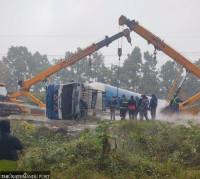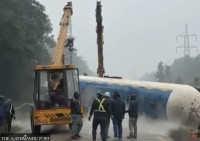National
Surveillance to protect red panda cubs begins in hill districts of Province 1
The nurturing season of red panda cubs has begun and this is the time when they are at their most vulnerable, say conservationists.
Ananda Gautam
Cryca Sherpa, a resident of Hangdewa in Phungling Municipality Ward No. 9, Taplejung, used to collect fodder from the forest areas in Pathibhara. But he hasn’t been there ever since the local community group banned people from entering the woodlands.
The group came up with the move to protect the endangered red panda species and their cubs, which are especially vulnerable to any unfavourable conditions like frequent human movement in their environment.
“For the time being, the ban has not affected us, as we have plenty of grass in our fields,” said Sherpa, who is also a member of the local community group that is working to save endangered species.
The breeding season for red pandas begins at the end of May and lasts until the end of July. However, in the following months until October, the mortality rate of red panda cubs is high. This has prompted conservationists to appeal to the public to leave the habitat of these endangered mammals undisturbed.
Consumer committees and local communities in Taplejung, Panchthar and Ilam districts, the major habitat of red pandas, have begun surveillance of red panda cubs as a part of the species’ protection drive. It is estimated that more than 134 red pandas are found in these three eastern hilly districts
Wangchu Bhutia, the programme coordinator of the Red Panda Network, said the time period in between May and October is of great significance in red panda conservation.
“If red pandas find their habitat disturbed, they tend to move to another area with their cubs. The newborns are vulnerable to this frequent change in location and could die due to unfavourable conditions in their new surroundings,” said Bhutia.
According to the study performed by Pralad B. Yonzan, a conservationist, in Langtang National Park in 1989, 86 percent of red panda cubs die at an early age. The study showed that this high mortality rate of the cubs has posed a challenge in the conservation of the endangered species.
Conservationist Bhutiya said increased human activities in the forest areas—like the expansion of the Suketar-Kafle Pati road and the Suketar-Deurali-Sikaicha road—has disturbed the district’s red panda habitats.
“Red pandas get frightened by loud noises made by vehicles and humans while cutting fodder and firewoods inside the forest. They need a peaceful environment while reproducing and nurturing their babies,” Bhutiya said. “If there is any kind of outside intervention, they tend to leave their birthing dens along with their offspring.”
To prevent this from happening, the community group has prohibited vehicles from blowing horns along the Suketar-Kaflepati road and the Suketar-Thawakhola road, as loud noises disturb red panda habitats.
Red pandas are able to reproduce at around 18 months of age. They build birthing dens in a hollow tree or a tree stump and line them with leaves, grass, moss and tree branches to nest their young.
Ramesh Rai, the programme coordinator of Himali Conservation Forum, which conducts conservation programmes in various community forests in 14 wards of different municipalities of Taplejung district, said the forum has requested locals not to construct roads, cut trees, collect stones and break boulders, and collect fodder and firewoods near forest areas.
According to Rai, the locals have been very cooperative in their drive to protect and conserve red panda species.
“We don’t enter forests to collect fodder and firewood in the monsoon. Grass for cattle is easily available in farmlands. So there’s no problem,” said Pasang Sherpa, a resident of Bungkulung in Phungling Ward No. 9. He said the locals are complying with the community groups’ requests to help conserve the endangered species.
Dhanraj Tumbapo, who used to be in charge of a temporary police post in Upper Phedi, which is 22.5 kilometres from the district headquarters of Phungling, said red pandas are especially vulnerable during their breeding season and the first three months of their birth, when they are at high risk of attack by stray dogs.
“Many times, I have seen dogs attacking red pandas in Upper Phedi. The local community must come together to protect red pandas,” Tumbapo said.
Meanwhile, Pasangrita Sherpa, chairman of Pathibhara Community Forest Consumer Committee, said they have requested locals not to let their dogs roam the forest areas this season.
“The locals are aware of the red panda conservation efforts. If they disobey the rule, the community forest will take necessary action against them,” he said.
The local community groups have been preparing an annual timetable that informs locals when they can enter the forests for firewood and fodder collection.
According to the Red Panda Network, 25 percent of an estimated 500 red pandas in Nepal are found in the three eastern hill districts. The data of the network showed that the animal species is found in 23 districts in the country.
Red Panda, known as Habre in Nepali, is one of the rare animal species inhabiting the temperate forests with abundance of bamboo in Nepal, India, Bhutan, northern Myanmar and southwestern China. The estimated number of red pandas is less than 10,000 in the world.
Conservationists say construction of roads through red panda habitat, deforestation, forest fire, poaching, excessive grazing, attack from predators and loss of food sources are the major challenges facing red panda conservation. Moreover, parasitic infections found in red pandas during a recent study further worries conservationists
Khile Sherpa, a local community user in Bunkulung, said they are allowed to enter forests between mid-February to mid-April, before the start of monsoon every year.
“During that period, we collect firewood that can last for four to six months. But during monsoon, we are not allowed to enter forests in accordance with the annual plan,” Khile Sherpa said. “We know if we enter the forest areas during monsoon, our activities will disturb red panda habitat. This is why we utilise the grass and fodder available in our fields during the monsoon season.”




 17.12°C Kathmandu
17.12°C Kathmandu













%20(1).jpg&w=300&height=200)

